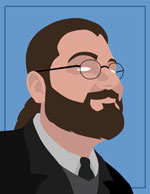Yesterday afternoon I spent a couple really terrific hours geeking out over the work of Alex McDowell, the production designer for Minority Report, The Corpse Bride, The Terminal, Fight Club, Charlie and the Chocolate Factory, and a number of others. McDowell is the new artist-in-residence for the Media Lab, working with Tod Machover on this crazy new robot opera project, and yesterday he gave his “this is who I am” presentation with a Keynote presentation of concept art and commentary from his films.
One of the major highlights was hearing McDowell describe how his sets are often characters in their own right – a cliche that gets bandied about quite often by pretentious set designers, but then he demonstrated how in his case this makes total sense. For instance, he showed us a top-down view of the Precrime Unit in Minority Report, which is laid out like the ripples emanating out from a pebble thrown into a pond, which is pretty much the effect the precogs were having on their society. He also told us about how the crumbling old house in Fight Club is barely in the script at all, but the design team created this amazing backstory for this industrial baron who had bought this Victorian mansion but abandoned it when the factories and other industrial fallout engulfed the green space around his home. In the 70s it had been converted into a duplex, but was then abandoned again for the squatters to move into – which parallels the life of Edward Norton’s character, living an increasingly IKEA-ized lifestyle until it all becomes too much for him, which opens up his brain for Brad Pitt’s character to move into. Wicked cool in and of itself, but then he also told us a story about how they used chemicals to artificially age the building and make the paint peel, but big chunks of the paint kept falling off the walls because the chemicals worked too well.
I think my favorite story, though, was how his teams are using Maya to do things that I would have never expected. Previz, sure. Special effects, sure. But these guys used Maya to create a massive matte painting for the backdrop to the terminal in, well, The Terminal. First they modeled this virtual terminal at JFK and then plunked it into a model of the real JFK, then forced the perspective on it so it would be semicircular, then sent it to a matte painting shop to create this ginormous piece of art to stick outside the set’s windows. McDowell chuckled as he noted that they did this instead of bluescreening so that Spielberg wouldn’t shy away from having the windows in the shots – since anything done with bluescreen was going to be somewhere around $75,000 to composite. Wow.
Have I mentioned lately that I love it here?

Storyteller, scholar, consultant. Loving son, husband and father. Kindhearted mischief-maker.
I'm the Director of the Games and Simulation program at Miami University in Ohio, where I am also an Assistant Professor in the College of Creative Arts' Emerging Technology in Business and Design department. I'm also the director of Miami's Worldbuilding and Narrative Design Research Laboratory (WNDRLab). I have a Master's in Comparative Media Studies from MIT and a PhD in Media Arts and Practices from the University of Southern California.
In past lives I've been the lead Narrative Producer for Microsoft Studios and cofounder of its Narrative Design team, working on projects like Hololens, Quantum Break and new IP incubation; in a "future of media" think tank for Microsoft's CXO/CTO and its Chief Software Architect; the Creative Director for the University of Southern California's World Building Media Lab and the Technical Director, Creative Director and a Research Fellow for USC's Annenberg Innovation Lab; a Visiting Assistant Professor at Whittier College and director of its Whittier Other Worlds Laboratory (WOWLab); the Communications Director and a researcher for the Singapore-MIT GAMBIT Game Lab; a founding member of the Convergence Culture Consortium at MIT (now The Futures of Entertainment); a magazine editor; and a award-winning short film producer. more »
The opinions put forward in this blog are mine alone, and do not reflect the opinions of my employers.

